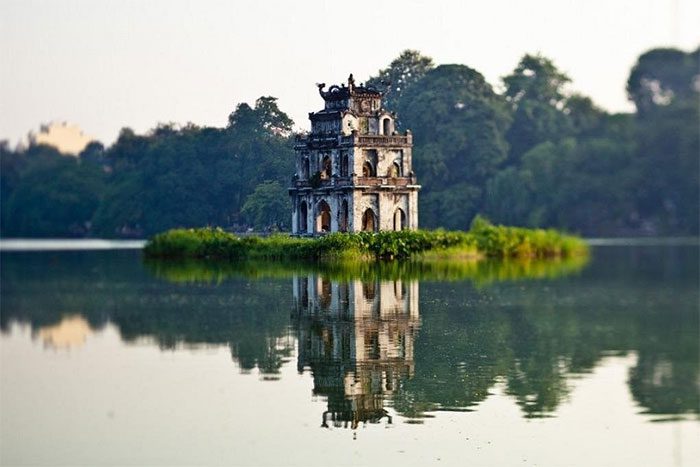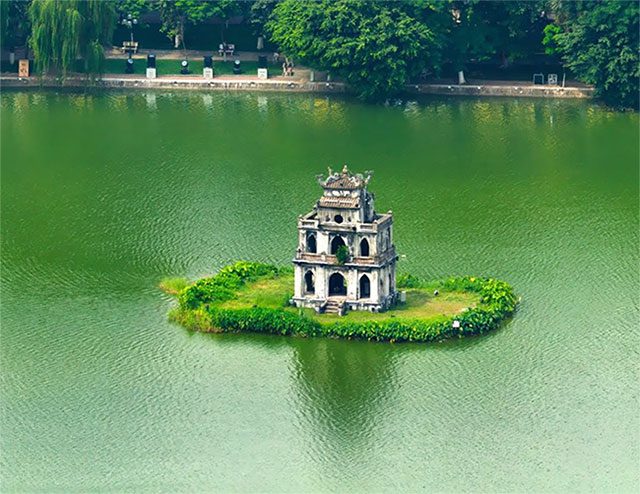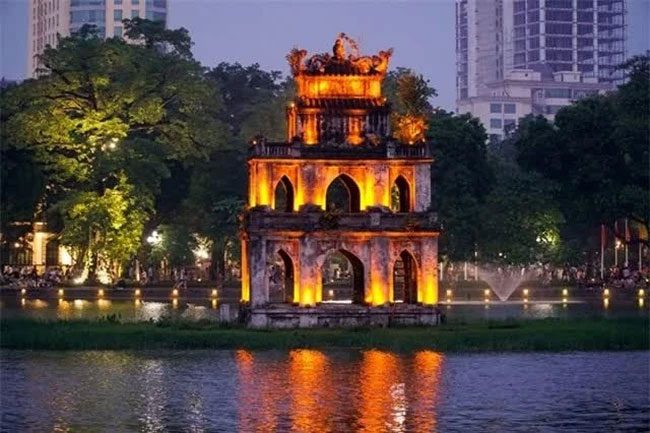Previously, atop the Turtle Tower, there was a beautiful statue built by the French. The “Heart of Hoan Kiem” has many names and is associated with fascinating stories that few people know.
When discussing the symbols of Hanoi, Turtle Tower is undoubtedly mentioned. It is not only a small tower situated on an island mound in the Hoan Kiem Lake, but also a historical witness, embodying the legends and cultural heritage of the capital. Consequently, anyone visiting Hanoi, passing by Hoan Kiem Lake, is impressed by the Turtle Tower.
 Turtle Tower is considered the “heart of Hoan Kiem Lake,” one of the symbols of Hanoi. (Image: Internet).
Turtle Tower is considered the “heart of Hoan Kiem Lake,” one of the symbols of Hanoi. (Image: Internet).
Despite its fame, there are likely many stories about Turtle Tower that people are still unaware of. The mound where Turtle Tower stands was first constructed as a fishing pavilion by King Le Thanh Tong. During the Le Trung Hung period, Lord Trinh built the Left Vong Temple there. However, during the Nguyen dynasty, this site completely lost all traces of its past. In 1886, Mr. Kim, a middleman between the French and the Vietnamese, had a three-tiered tower built here, believing this mound was very auspicious. This special name for the Turtle Tower originated from this time: Kim’s Tower.

Turtle Tower has many lesser-known names. (Image: Internet).
But this is not the least known name of Turtle Tower. It is said that inside the tower, near the west wall, there is an altar, but no one knows who it is dedicated to or when it was established. The east wall of the third floor bears the inscription “Quy Sơn Tháp” (Turtle Mountain Tower). Legend has it that this is where the legendary turtle of Hoan Kiem Lake often rested and basked in the sun. The name “Quy Sơn Tháp” is something many people may not have heard of, but it is recognized by many experts as an alternative name for Turtle Tower.
During the French colonial period, a statue of the Goddess of Liberty, a smaller version than that in the United States, once stood atop Turtle Tower. The people of Hanoi sarcastically referred to it as “the lady with the wide skirt.” By the 1950s, the statue had been demolished and no trace of it remains today.
There are rumors that Mr. Kim intentionally built the tower on this mound because he believed that if he buried his parents’ remains there, his descendants would forever hold high positions. He arranged for the remains to be placed in the mound beforehand. However, when construction began the following day, the two skeletons had been unearthed and tossed into the lake. Mr. Kim could do nothing but remain silent, pretending as if nothing had happened. This is merely a rumor, with no documented evidence to support it.

The stories surrounding Turtle Tower are always a mix of reality and myth. (Image: Internet).
However, as historian Le Van Lan once stated in the “Buddhist Studies Journal”, issue 1 of 2015, the stories surrounding Turtle Tower inherently blend fiction and reality, legend and history. It is known that at any period, this remains a symbolic, cherished, and sacred structure of the capital city of Hanoi.


















































